Ask any CMO about the future of marketing—and you can bet your last donut that you’ll hear “AI.” Most modern CMOs never spell a “marketing strategy” without this two-letter abbreviation nearby. They’re discussing the advantages and perspectives of using artificial intelligence in their newsletters, blogs, podcasts, social media posts, and elsewhere. But how many CMOs actually tap into AI marketing, and how exactly?
The general answer would be nearly all: 96% of marketing departments have already exploited AI for at least one activity. If you need more details, here’s another research from BCG breaking down activities and percentages of marketers using AI for those:
- For text and image creation: 30% and 36%
- For animated video generation: 28%
- For customer insights and trend forecasting: 30%
- For audience segmentation and optimization: 36%
- For content personalization: 50%
So, let’s find out what kind of CMOs are using AI prefering for these tasks and what precious AI gems they store in their marketing vaults.
What AI Types Are Used by CMOs for Marketing?
Generative AI (GenAI)
Whether you want to type product descriptions or Instagram captions as a marketer, you simply indicate your idea/topic and click “Generate”—and there you have them all! Generative AI does that time-draining job instead of you.
It’s that easy, and that’s why it’s the most attractive type of AI on every CMO’s radar, beckoning them to give it a try (and a prompt).
Although 27% of CMOs are still sitting on the fence, stuck with the dilemma of “to use” or “not to use” GenAI, 47% are already harvesting its benefits. The primary advantage? It saves hours of manual work and produces content automatically.
Let’s name several GenAI tools for marketers:
- For texts: ChatGPT, CopySmith, AgilityWriter.ai, Copy AI
- For images: Leonardo.ai, GenCraft, Midjourney, Flair.ai
- For videos: Vidoso.ai, Invideo.io, Pollo AI
- For sounds and audio files: Soundraw.io, Voicemod AI, Lalal.ai, Respeecher
But then, there are the so-called “omnipotent” generative AI tools with a wide range of features. Writecream is one of those species. It offers an all-encompassing AI suite, from an AI copywriter to a natural text-to-speech generator.
For example:
One of the marketing directors cut their content creation time by 70% (!) with Writecream’s AI.
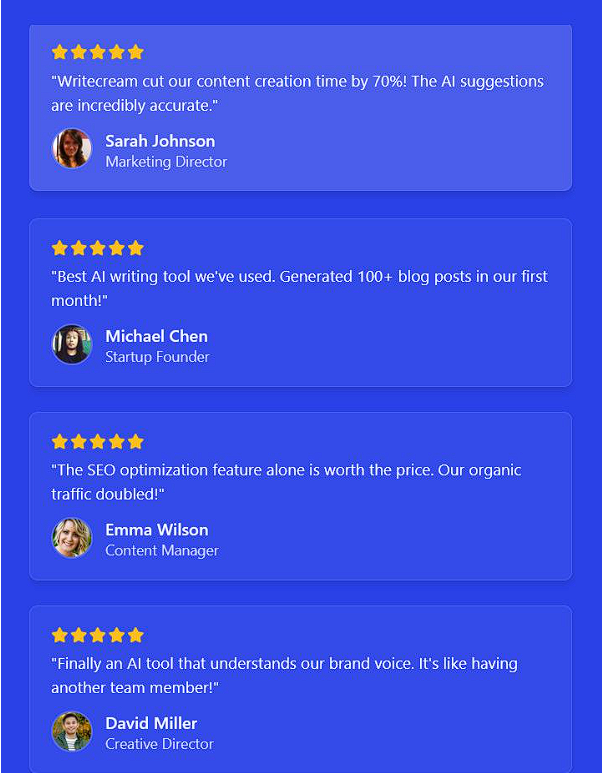
Analytical + Predictive AI
It’s like a crystal ball that “fortune-tells” data-driven customer insights, allowing CMOs to peek into the future of marketing with AI:
- Possible risks → Where may your marketing efforts vanish into thin air with campaigns buried in the silent graveyard of unsuccessful ideas?
- Current trends → What trendy waves should you hop on and ride ASAP?
- Projected opportunities for growth → What promotional strategies should you prioritize in the coming months/years while leveraging the wins from the past and the forecasts about the future?
For example:
Let’s roll with the idea that you want to implement analytical AI tools (take Riyo.ai or Zipy.ai) on your eCommerce website. They can help you improve productivity and streamline your workflow, analyze website traffic and understand customer behavior on each web page to see what drives clicks and conversions and what doesn’t.
Additionally, professional marketers also turn to AI forecasting tools for pricing strategies, such as Yieldigo or FutureUp.io, to set up dynamic prices and promos based on market predictions.
At the same time, some brands invest in developing their own AI systems for predictive analytics to stay ahead in the marketing landscape.
For example:
As stated by Michael Bailey, Senior Marketing Director at Google Media Lab, Google created an internal predictive AI model in 2024. Based on its intelligent insights, they can now find and reach new “similar users on services like YouTube, Google Display Network, and Search.”
Conversational AI
Basically, it’s another player (just digital) on the CMO’s team who never burns out of waving and saying: “Hey, how can I help today?” It handles FAQs, books appointments, and even cross-sells products or services whenever appropriate. And even when it’s 4 a.m. And even when it’s Sunday, and there’s no one in the office.
So, consider these variants of conversational AI frequently used by marketers:
- AI chatbots (Chatling.ai or Wonderchat.io)
- Messaging AI for socials (ManyChat AI or Heyday by Hootsuite)
- AI virtual assistants (Conversica or Exceed.ai)
- AI voice clones (Voices.com or Resemble.ai)
When it comes to conversational AI bots, in particular, 43% of CMOs and executives plan to use them for marketing purposes in the next couple of years.
But even today, you can already observe numerous cases of conversational AI in financial services, education, healthcare, and other industries. Let’s see an AI chatbot for finance in action.
For example:
Here’s how IRIS, a virtual AI assistant at Apprisen, responds to the user inquiring about a custom debt relief program.
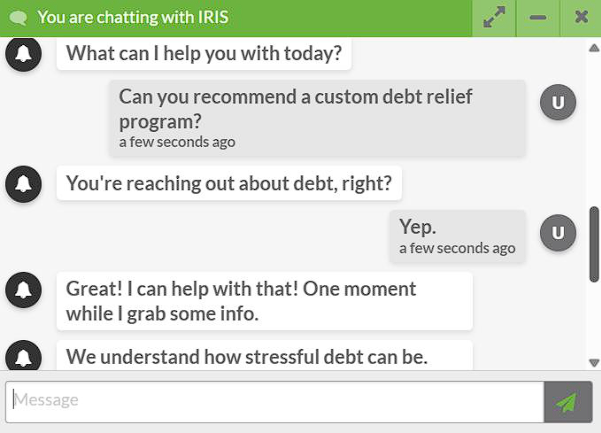
Or—
Look at this conversation with Tim Bond, an AI bot used by TeamBonding to attract and pull leads into the B2B sales funnel.

“Add-On” AI
So far, we’ve majorly covered autonomous, independently operating AI tools in marketing.
Now, there’s another class of AI actively adopted by CMOs: “add-on” artificial intelligence for improved workflow. It’s typically added on top of already existing functionality in platforms or software that didn’t have AI capabilities prior to AI’s advent.
For example:
Just recently, Amazon launched an AI-powered video maker as a new feature for sellers. Now, they don’t have to leave the marketplace to create next-gen videos for Amazon Ads.

Alternatively, let’s take Shopify. In 2023, it introduced the Shopify Magic suite, featuring GenAI capabilities to automate tasks such as writing product descriptions, emails, and blog posts.
Having the e-store of wooden massagers and kitchenware on Shopify, Peter Čuček, Owner of Tuuli, remarks, “If you’re already running a business on the platform like Shopify or Amazon joining the AI revolution, it’s a splendid chance to smoothly glide into AI marketing with minimal effort. Plus, as a CMO or business owner responsible for budgeting, you don’t have to overspend on standalone AI tools for marketing.”
How CMOs Are Using AI to Drive Personalization and Stay Ahead in the Market
In today’s competitive landscape, CMOs are using AI to transform marketing, drive personalization, and stay ahead of rapidly shifting customer expectations. As highlighted in a global survey of 200 CMOs conducted in April and May by Boston Consulting Group, more than 75% of successful CMOs report they plan to invest at least 10% of their budgets into AI over the next three years. This shift reflects how CMOs are using AI to turn insights into impact across every function of marketing and sales.
Key drivers behind this transformation include:
-
The need for cross-functional collaboration between sales teams, creative teams, and data scientists
-
The adoption of agentic AI and AI agents to optimize content, messaging, and campaign deployment
-
Strong pressure on CMOs to increase marketing efficiency, improve operational efficiency, and accelerate business growth
-
Rising importance of first-party data and customer data in building personalized campaigns
-
Expectations for human creativity to merge with automation in tomorrow’s marketing
A growing number of successful marketing organizations are already deploying AI strategies and AI implementation that harness AI to unlock new levels of agility and strategic thinking. These tools support agile ways of working, smart data literacy, and measurable impact across marketing processes and marketing operations. As CMOs already feel the pressure to evolve, they’re turning to ai-driven marketing landscape tools to optimize marketing and reshape their marketing technology stacks.
According to the consulting group, those already using AI are reaping the benefits:
-
AI enables seamless integration of campaign workflows
-
AI to enhance creative generation and predictive insights
-
Ability to deploy AI across marketing functions improves decision-making
-
AI can help create more personalized and relevant customer journeys
-
Embracing AI within organizations boosts true marketing potential
Insights from the global survey show that CMOs are scaling GenAI as part of their core strategy, even during scaling GenAI in turbulent times. The smartest CMOs recognize that AI enhances not just performance but also the culture of marketing leadership through more effective thought leadership content and stronger collaboration.
Ultimately, CMOs need to understand how to deploy and manage AI responsibly. The fusion of AI adoption, advanced marketing technology, and creative teams will be the foundation of tomorrow’s success. For those ready to lead, CMOs are using AI not just as a tool—but as a transformational force for the future.
The CMO’s Guide to AI in Marketing with Use Cases and Tools
AI in Email Marketing: Revive Your Emails
Years ago, email marketers, together with CMOs, crossed their fingers after clicking the “Send” button and hoped for the subject line to compel and convert. Now? Artificial intelligence takes full charge (and supercharge!) of emails, not solely subject lines.
AI can indeed accomplish practically everything for successful email marketing:
- Generate compelling subject lines that boost open rates
- Segment the audience and adapt the tone and style for different customer segments
- Craft personalized emails
- Pick the best times for sending
- Track email metrics: opens, click-throughs (aka CTR), unsubscribes, spam complaints, etc.
- A/B test emails
- Predict subscriber churn and suggest win-back tactics
Sean Shapiro, Managing Partner at Axia Advisors, observes, “There’s a common misconception that email marketing died with the rise of social media and messengers. In reality, AI breathed new life into it. Both B2C and B2B emails have largely evolved thanks to AI.”
For example:
Axia Advisors’ B2B lead-gen emails are powered by GetResponse, just like this one with a lead magnet, “The Roofing Exit Playbook.”
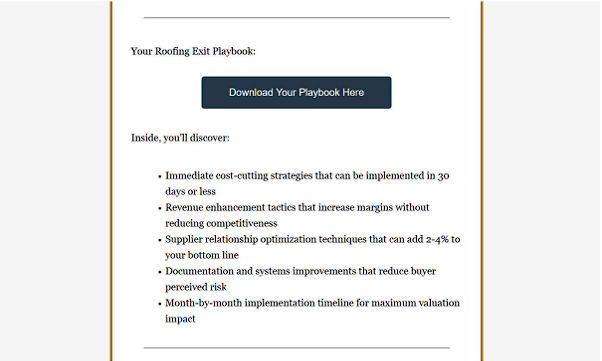
GetResponse has a built-in GenAI writer for subject lines and email copies.
Other AI tools for email automation: WriteMail.ai, MailMeteor, Friday-Email.ai, MailerLite
AI in Social Media Advertising: Optimize Your Ad Performance
Are your social media ads draining your pockets rather than generating ROI?
Most probably, this happens because you haven’t tried AI-driven ad targeting and performance monitoring.
Once you start using AI for marketing and advertising as its subset, you’ll know what ad type converts your target audience, on which platform, and at what time exactly:
- Image ads
- Video ads
- Sponsored tweets
- Carousel ads
- Promoted pins
- Click-to-message/chat ads
- And others.
Remarkably, most social platforms have add-on AI tools for advertising.
For example:
In 2022, Facebook created Meta Advantage+, an AI-powered suite for ad performance optimization. Then, TikTok also introduced an AI Ad Assistant built into TikTok Ads Manager to help marketers analyze and refine ad campaigns on the platform.
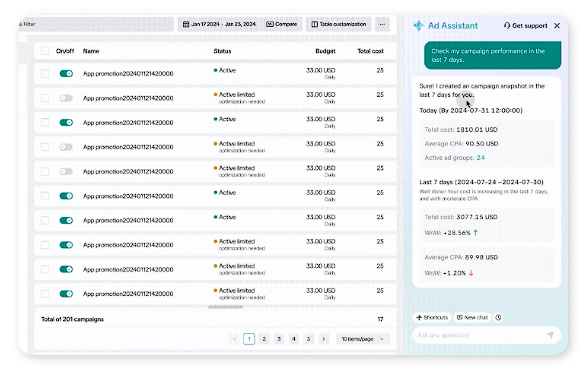
Other AI tools for effective targeted advertising: AdCreative.ai, Pattern89, Smartly.io
For example:
Foot Locker’s marketing team used Smartly.io for Dynamic Product Ads on Facebook.
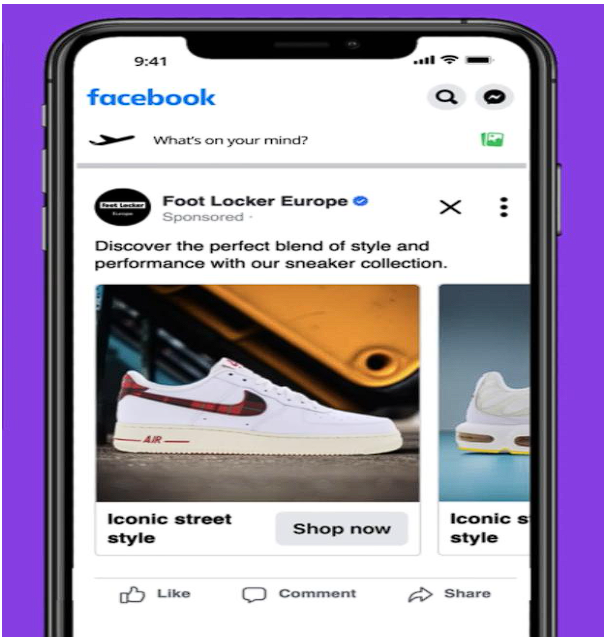
Jasmin Kreiken, Director of Digital Marketing & Media at Foot Locker, said, “Smartly’s GenAI solution helped us not only scale and automate content production but also improved campaign performance massively”: a 28% lower CPA and 32% higher CTR.
AI in Customer Experience (CX): Personalize
Customers don’t come off an assembly line as identical personalities. So, naturally, a copy-paste approach fails in marketing. That’s when AI helps CMOs create unique experiences for every customer with personalized marketing strategies that work.
Of course, you may argue that it’s possible to do that single-handedly (e.g., send personalized product recommendations via email or even record videos for each person individually). Yes, it is, but only if you have several customers. But what if you have hundreds, thousands, or millions of them?
Quoting Michelle Crossan-Matos, Chief Marketing Officer at Ulta Beauty, “You cannot serve content to 42 million loyalty members if you don’t have AI enabling you to tailor and personalize.” Ulta Beauty’s AI journey started in 2018 with a virtual assistant for shopping. Later, the beauty brand invested in an AI-enabled consultation tool, SkinAnalysis, to personalize customers’ skincare routines.

Or—
Let’s look at another example of AI-powered personalization and hear out Leon Huang, CEO at RapidDirect. Working shoulder to shoulder with the company’s CMO, Leon Huang is also a persistent supporter of innovative technologies like AI in all business processes. He says, “Our top priority is to deliver excellent customer experiences in on-demand manufacturing. With this mission in mind, we’ve developed an innovative platform for customers to receive AI-generated personalized quotes for their custom prototypes and designs.”
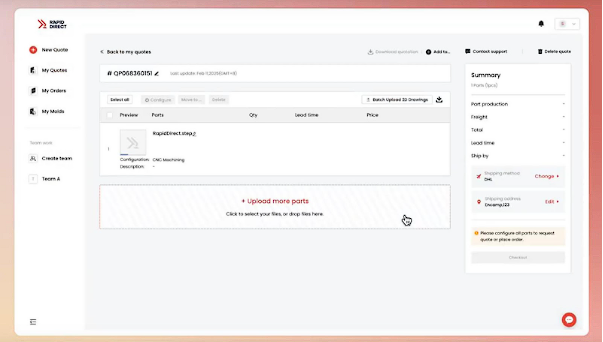
AI in Feedback Collection: Analyze Customers’ Voices Automatically
There’s no denying that AI is a surprisingly good listener and feedback collector.
It is already assisting CMOs and their teams with the following:
- Capture every customer’s voice from reviews, chatbots, social networks, customer survey emails, support tickets, etc.
- Analyze sentiment (positive/negative/neutral)
- Follow up and thank customers for their feedback (e.g., generate a customer review response)
- Summarize and translate (sometimes literally—multilingual feedback) customer voices into insights
- Notice recurring problems and predict customer behaviors
For example:
Ian Gardner, Director of Sales and Business Development at Sigma Tax Pro, notes, “We deeply care about how our tax software users—prospective and existing—feel and strive to hear everyone across multiple channels. For that, we’re using AI-powered tools like Hotjar for website feedback analytics and Verified Reviews for automatic review management via email and SMS.”
Here’s a Feedback Widget from Hotjar that Sigma Tax Pro embedded on the website.
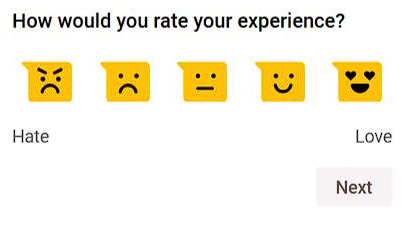
Among other AI features, Hotjar offers advanced analytics with filtering and tagging to help marketers understand user sentiment and pinpoint issues users may encounter on web pages.
Other AI tools for customer feedback: ChatterMill, SentiSum, Canny.io
No More Talks—See How Writecream’s AI Works
At the final point, let’s bring GenAI to your attention once again and think about how it can meet your marketing needs. But if you have already thought it through and are ready to explore its potential, taste the future of marketing with Writecream’s AI.
Start generating content for free and enjoy every sweet byte of it.

